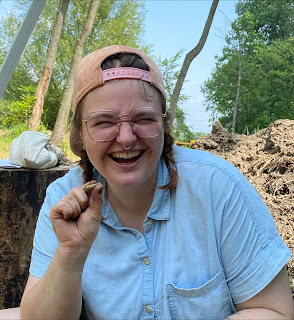Hello fellow archaeology enthusiasts!
It’s Hollie again from unit N10 E3. It has been a great few weeks out at Fort St. Joseph Archaeological Project and things are about to get even more interesting! As we are making our way through the plow zone toward the occupation zone, we are uncovering more and more 18th century artifacts. We have been particularly excited to find fragments of clay and stone pipes over the last couple of weeks. While excavating and wet screening our unit, Emma and I were fortunate enough to find 4+ clay pipe stem fragments as well as a pretty large piece of a stone pipe bowl! Several others at the site, classmates, campers, and volunteers, have also discovered clay pipe stems and an additional piece of a stone pipe bowl.Though not an overly uncommon find at FSJ, pipe stems can tell us more than one may think about this historic site. Pipe stems are, like their name suggests, the stems of smoking pipes used for recreational and spiritual smoking of tobacco and other substances. First crafted and used by Indigenous Americans, Europeans began crafting their own clay pipes during the early 1600s. It appears that the pipe stems commonly found at Fort St. Joseph, and in unit N10 E3 specifically, are of European, not Indigenous American origin. The white clay pipes crafted by Europeans were less expensive to produce than obtaining Native American-made clay pipes but have been found to be more fragile than those of their Native counterparts. Those excavated so far this summer have been from the plow zone and range from around 1 to 4 centimeters in length. It is likely that the somewhat fragile pipes were broken, or further broken, by the plowing that took place in the area. These pipe fragments are particularly interesting because they can tell us not only about the social and spiritual practices of local Indigenous peoples and occupying Europeans, but about the age and occupation of the fort itself.
Upon initial observations, the pipe stems appear quite similar in appearance; however, the fragments of clay pipe stems excavated at FSJ all have one feature key in distinguishing them from each other, and perhaps more importantly, from other pipe stems not found or less commonly found at the site. This important feature is the bore hole going through each of the stem fragments. Archaeologists have been able to determine that the width of pipe stems holes corresponds to the years in which they were manufactured. Additionally, the hole sizes can help tell us if the pipes we are finding were locally traded items or ones imported from Europe. Though it cannot account for the exact duration of years in which the pipes were distributed and traded, this system of dating played an important role in initial dating of Fort St. Joseph.
Stone pipe bowls are thought to have increased in popularity during the early 18th century, perhaps in response to the fragility of European made clay pipes. Interestingly however, stone pipe bowls have been a significantly less common find at the FSJ Archaeological Project thus far. The stone pipe bowl pictured is the one Emma and I found in the west wall of our unit on Thursday, July 27th. The wisdom of Dr. Michael Nassaney, alongside additional research, has revealed that the fragment belongs to a Micmac style pipe, likely originating from Maine or northeastern Canada. Unlike the pipes previously mentioned, this pipe bowl was not equipped with an attached pipe stem. Instead, it would have had a separate wooden, often highly decorated, detachable stem. Micmac pipes were more distinctly spiritual than clay pipes made and used during the same time. Said pipes were initially used amongst the Mi’kmaq people only with nonrecreational herbal blends and tobacco for spiritual ceremony. Later, as the pipes were adopted by Europeans and other Native American groups, their original spiritual intentions became blurry. They were increasingly used for recreational purpose, forgoing the strong ceremonial emphasis of the Mi’kmaq people. They additionally became more ornate as their popularity grew, losing their humble spiritual beginnings.
The pipes are thought to have originally symbolized the balance of peace between man and woman and between nature and human interactions. As they gained popularity however, their meaning evolved to a more generalized symbol of peace, particularly between native groups and between Europeans like those at FSJ and Native American locals like the Potawatomi. It is additionally believed that smoking stone pipes in the presence of each other indicated cordial relations. The presence of Native American made pipes at Fort St. Joseph provides further evidence of trade and relations between local indigenous groups and the European occupiers of FSJ.
- Hollie
References
Muin’iskw, & Crowfeather. (2016, March 25). Mi’kmaw Spirituality- The Sacred Pipe. Mi’kmaw culture - spirituality - the sacred pipe. https://www.muiniskw.org/pgCulture2f.htm
McMillan, Lauren K. (2016) "An Evaluation of Tobacco Pipe Stem Dating Formulas," Northeast Historical Archaeology: Vol. 45 45, Article 3.
Rafferty, S. M., Mann, R., & Nassaney, M. S. (2004). Ch. 4- Men and Women, Pipes and Power in Native New England. In Smoking and culture: The archaeology of tobacco pipes in eastern North America (1st ed., pp. 125–141). University of Tennessee Press.


No comments:
Post a Comment